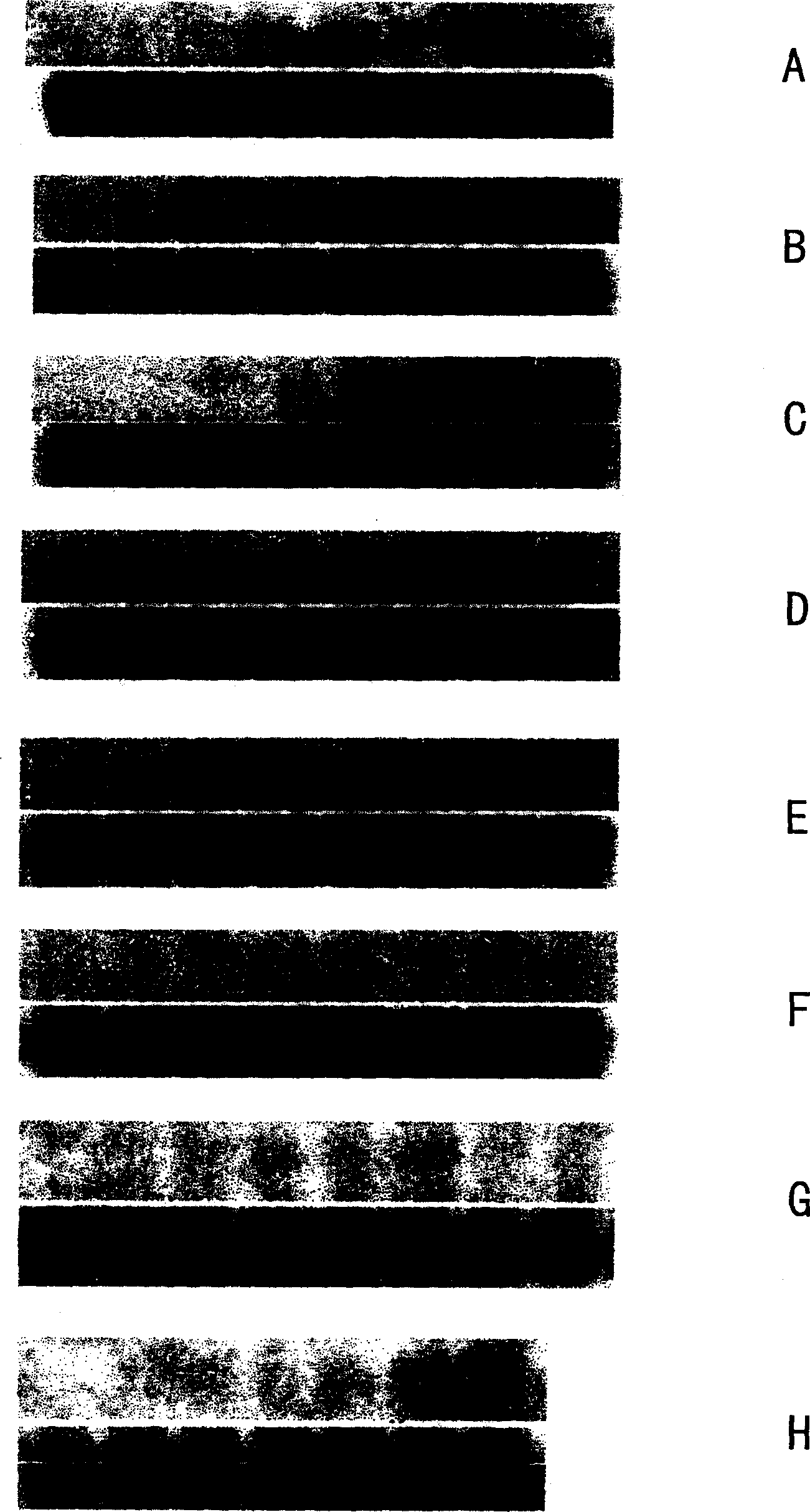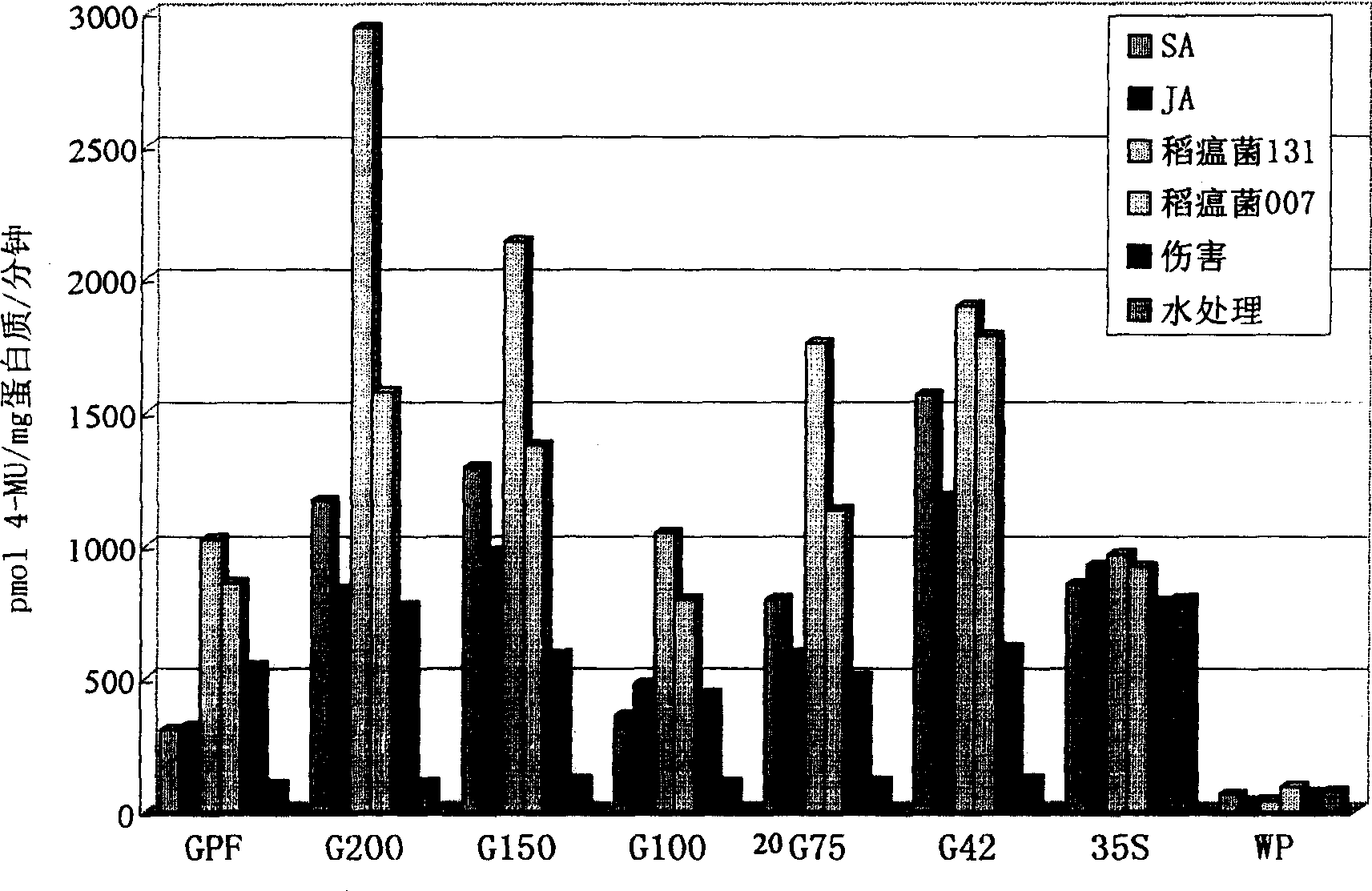Pathogen from rice, chemically inducible promoter and their use
A rice, nucleotide sequence technology, applied in the fields of organic chemistry, biochemical equipment and methods, applications, etc., can solve the problems of slow speed, signal transmission defense system, plant susceptibility, etc.
- Summary
- Abstract
- Description
- Claims
- Application Information
AI Technical Summary
Problems solved by technology
Method used
Image
Examples
Embodiment 1
[0030] Example 1 Cloning of the POG promoter of the blast fungus infection-induced gene
[0031] 1. Purification of rice peroxyhydroxy fatty acid hydroxyl cyclooxygenase (POG) Prepare the rice variety Aichiasahi (Oryza sativa cv Aichiasahi), and when the 4-5 leaves are pulled out, the rice inoculated with non-compatible blast fungus Leaves were used as experimental materials, through selective extraction of membrane proteins, 20% saturation ammonium sulfate precipitation to remove impurities and 45% saturation ammonium sulfate salting out, DEAE-Toyopearl anion exchange, DEAE-Sepharose anion exchange, CM-Toyopearl (pH5 .1) Through the steps of cation exchange, CM-Toyopearl (pH4.5) cation exchange and ultrafiltration concentration, the infection-induced POG of Magnaporthe oryzae was purified, and the electrophoretic pure enzyme protein was obtained. The N-terminal amino acid sequence of the POG is determined by using a lysine-specific Lysyl endopeptidase enzymatic hydrolysis met...
Embodiment 2
[0037] Example 2 Inducible expression characteristics of POG gene
[0038]Aichiasahi (Oryza sativa cv Aichiasahi) was used as the tested rice variety. Use Magnaporthe grisea race 131# which is not compatible with this variety and race 007# which is compatible with the variety as inoculum. The preparation method of Magnaporthe oryzae spores is the same as that of Peng et al. (Can. J. Biol., 66: 730-735, 1988). When the 5th leaf of the rice seedlings is nearly fully unfolded, rice blast is used to spray and inoculate rice with spore suspension (106 / ml), and then cultivated in the dark at 100% at 28° C. for 36 hours and then cultured in the light, with 0.02% Tween Mock inoculation of -20 spray was used as control. Samples were taken at 0h, 8h, 16h, 24h, 36h, 48h, 60h, and 72h after inoculation, and the middle part of the fifth leaf was cut when sampling. Other physical and chemical treatments are as follows: JA treatment: Spray 100 μM JA on the rice leaf surface, and then seal...
Embodiment 3
[0040] Example 3 Obtaining of POG Promoter 5' End Gradual Deletion Derivative Variants
[0041] The upstream regulatory fragment of the 5-terminal of the POG gene was searched in the database and analyzed by software to infer its possible cis-element positions. Then, based on these positions, six POG promoter 5′-terminal gradual deletions were obtained by enzyme digestion and PCR. The fragments are respectively named as GPF (corresponding to nucleotides 163 to 2789 of SEQ ID.1), G200 (corresponding to nucleotides 807 to 2789 of SEQ ID.1), and G150 (corresponding to nucleotides 807 to 2789 of SEQ ID.1). 1286 to 2789 nucleotides), G100 (corresponding to SEQ ID.1 1635 to 2789 nucleotides), G75 (corresponding to SEQ ID.1 2038 to 2789 nucleotides), G42 (corresponding to SEQ ID.1 2038 to 2789 nucleotides), G42 (corresponding to SEQ ID.1 nucleotides ID.1 nucleotides 2363 to 2789). Among them, GPF is obtained by PCR amplification of plasmid POGH with artificially synthesized oligonuc...
PUM
 Login to View More
Login to View More Abstract
Description
Claims
Application Information
 Login to View More
Login to View More - R&D
- Intellectual Property
- Life Sciences
- Materials
- Tech Scout
- Unparalleled Data Quality
- Higher Quality Content
- 60% Fewer Hallucinations
Browse by: Latest US Patents, China's latest patents, Technical Efficacy Thesaurus, Application Domain, Technology Topic, Popular Technical Reports.
© 2025 PatSnap. All rights reserved.Legal|Privacy policy|Modern Slavery Act Transparency Statement|Sitemap|About US| Contact US: help@patsnap.com


